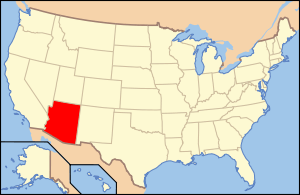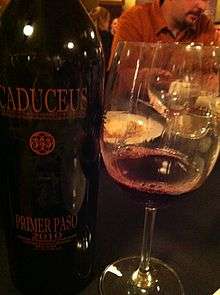Arizona wine
| Wine region | |
 | |
| Official name | State of Arizona |
|---|---|
| Type | U.S. state |
| Year established | 1912 |
| Years of wine industry | 16th century-present |
| Country | United States |
| Sub-regions | Sonoita AVA, Willcox AVA |
| Total area | 113,998 square miles (295,253 km2) |
| Grapes produced | Cabernet Franc, Cabernet Sauvignon, Chardonnay, Concord, Counoise, Gewürztraminer, Grenache, Malvasia, Merlot, Mourvèdre, Muscat Canelli, Nebbiolo, Petit Verdot, Petite Sirah, Pinot gris, Pinot noir, Riesling, Sangiovese, Sauvignon blanc, Syrah, Viognier, Zinfandel[1] |
| No. of wineries | Over 100 |
Arizona wine refers to wine made from grapes grown in the U.S. state of Arizona. There are three major regions of vineyards and wineries in Arizona:[2]
- Verde Valley – north of Phoenix on SR-260 and SR-89A near Sedona
- Sonoita – south of Tucson on SR-83
- Willcox – east of Tucson on the I-10
Most vineyards in Arizona are located in the southeastern portion of the state south and east of Tucson, which is also the location of Arizona's two designated AVA's (American Viticultural Area), the Sonoita AVA (established in 1985) and the Willcox AVA[3] (established in 2016).[4] Arizona has enjoyed recent success with wine made from the grape varietals native to Italy and the Rhône valley of southern France.[1]
Viticulture in Arizona began in the 16th century when missionary Spanish Jesuit priests began to plant grapevines and make wine for use in Christian religious ceremonies.
There now are over 110 wineries, vineyards and cellars[5] throughout Arizona, including in the cities of Phoenix and Tucson.[6]
The wineries, vineyards and cellars are supported by two state-wide organizations: the Arizona Wine Growers Association, a non-profit NGO representing, educating and promoting the state's wine industry, and by the Arizona Vignerons Alliance(AZVA), a non-profit organization collecting data on all Arizona wine-growing regions, ensuring authenticity of Arizona wine and working to promote Arizona wine as recognized, respected and sought-after in Arizona, the U.S., and globally.[7] AWGA supports the wine industry through promotional events, state awards to the best wines in Arizona and industry lobbying efforts at the local, state and national level. AZVA establishes parameters for growing grapes and producing wines in Arizona; verifies, certifies and promotes 100% Arizona wine; collects, evaluates and shares Arizona viniculture data; holds the annual AZVA Symposium and Wine tasting and participates in existing regional and international events to raise national and global awareness of Arizona wine; and promotes truth in labeling by giving the consumer and wine professional accurate information based on a data-driven and fact-based approach to wine labeling.
The Southwest Wine Center, established in 2009, is part of Yavapai College's Verde Valley Campus.[8] SWC provides education and training for the AZ wine industry through Yavapai College's Viticulture and Enology Program.[9] Students at YC can earn an AA in Viticulture and Enology or a certificate in Viticulture or Enology.

See also
- American wine
- Blood into Wine, a documentary film about the Northern Arizona wine industry
- Caduceus Cellars, an Arizona winery
- Kokopelli Winery, an Arizona winery
- Page Springs Cellars, an Arizona winery
- Sonoita Vineyards, first commercial winery and working vineyard in Arizona
- Superstition Meadery, an Arizona maker of honey-wine
References
- 1 2 Appellation America (2007). "Arizona: Appellation Description". Retrieved Nov. 27, 2007.
- ↑ "Visit AZ Wine Country – Arizona Wine". arizonawine.org. Retrieved 2016-12-11.
- ↑ Willcox AVA
- ↑ Alcohol and Tobacco Tax and Trade Bureau (2016-11-01). "Established American Viticultural Areas" (PDF). US Govt ATF. Retrieved 2016-12-11.
- ↑ Gartin, John (2016). "Wineries, Vineyards and Cellars of Arizona". Unpublished Research.
- ↑ "About Us – Arizona Wine". arizonawine.org. Retrieved 2016-12-11.
- ↑ "Arizona Wine Growers Association – Arizona Wine". arizonawine.org. Retrieved 2016-12-11.
- ↑ "- Southwest Wine Center Arizona". southwestwinecenter.org. Retrieved 2016-12-11.
- ↑ "- Viticulture and Enology School Arizona – Yavapai College". viticulture.yc.edu. Retrieved 2016-12-11.
External links